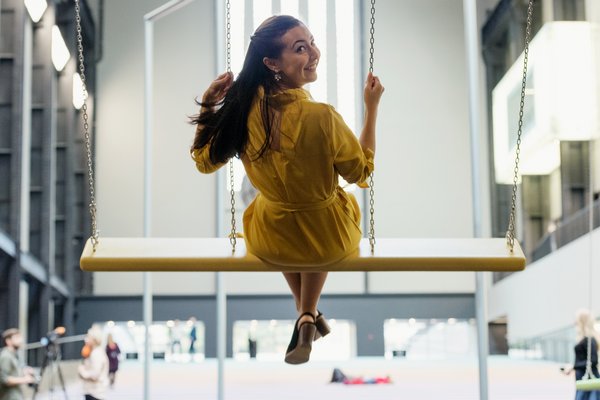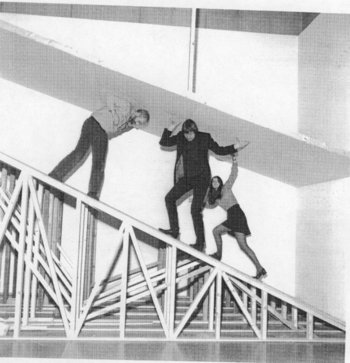Secondary Research
Tania Bruguera

Tania Bruguera is an installation and performance artist from Cuba. I saw one of her performances at Tate Modern which made me more interested in her work as it encompasses the political environment in which we're in today. After researching her latest installation at Tate Modern I wanted to discover more about her previous performances so I found 'Tatlin's Whisper #5'.
Tatlin's Whisper #5 consists of two mounted policemen in uniform that are brought into the museum space. As policemen they give directions to the audience just as they would normally do in another public space. The techniques used by the policemen to patrol the audience are common in most big events, yet what is interesting is how the context in which the subjects are found is very different and unusual. This performance made me think about how the authority tries to control the audience. By watching the video I felt at first that this was not an art performance but it was just a very unusual thing to experience. If I would have been in the space whilst it was happening I would have probably followed the policemen directions as doing what the authority told me to do is something that I never really questioned.
This makes me think a lot about power and control and how a person wearing a uniform can very easily lead us to believe that they have more authority than us - so they can therefore make us do whatever they wish.
"The people do not have to know that it’s art. And for me this is very important, because once you know it’s art, then you can do other associations, that are not exactly what you would do in your everyday life. So the fact that they are using and having the same reaction they have in real life when they see the police controlling them, for me is very important."
The quote above really caught my attention: although the context in which the policemen are found is different, the reaction of the public is the same. No one views the piece as an art performance therefore no one seems to question at first whether they should really follow the directions or not.
When it comes to interactive communication, as the audience interacts with the performance they start to make up their own interpretations of what the meaning might be and this is something that I would like to focus on for this project.
Bibliography: https://www.tate.org.uk/context-comment/video/tania-bruguera
SUPERFLEX - One Two Three Swing

Another piece of interactive communication I saw at Tate Modern was earlier this year when I visited the space and found the ground floor filled with swings . The swings have three places available so three people can swing at the same time. In this way the installation invites us to realise the potential of 'swinging together'.
What strategies have they used to initiate their intentions?
Although the concept may seem very simple, I think this piece was really effective as swings are something that most people played with as children so the sense of familiarity with the object makes the audience much more keen to interact with it. This is one of the reasons why I do not think that the artist used any kind of strategy to initiate the interactions because most people would be willing to go on a swing.
How successful were the interactions? What do you think made them successful?
I think the interactions were very successful: as the swings were designed to fit three people I think this feature encouraged the audience to take part in the interaction more because this way the viewers would not feel as intimidated or embarrassed to go on a swing. Moreover, the huge quantity of swings available made it more accessible for everyone to go on a swing and not feel like everyone's eyes were on one person only as this could have put most people off.
Did the interactive element make the work memorable? Why?
Yes, I think that the interactive element made the work memorable because if the audience would not have been able to go on the swings then it would have just looked like a sculpture and that, in my opinion, would have been totally different and very dull. By letting the viewers interact with the work I think the artists allowed them to have fun and take a moment to appreciate again the experience of going on a swing. In a way I feel like this installation encouraged adults to remember and cherish their moments of childhood in a safe space, making the work memorable for everyone.
Bibliography: https://www.tate.org.uk/whats-on/tate-modern/exhibition/hyundai-commission-superflex
Robert Morris - bodyspacemotionthings

Advert of his exhibition in 1971
In 1971, the artist Robert Morris filled the Tate Gallery (Tate Britain now) with sculptures created to be interactive. The museum-goers would experiment and put to test the sculptures with their own bodies. The sculptures themselves seemed very simple and minimalist; in my opinion the most important element was the interactive element of the pieces that made it successful.
I was drawn to his work because I found it compelling how he worked with sculptures but added an interaction with the pieces of work he created. It could be argued that even the swings created at Tate Modern earlier this year were interactive sculptures; I think taking the idea of creating something that is regarded as very classical and using it to challenge the perception of the viewer by allowing them to access and use the work in whichever way they please is a very interesting idea and it's what I am most looking forward to explore this week.

Reading more about the work of Robert Morris I started to think of ways I could create an interactive piece using sculptures or something 3D. As the last two artists I researched both created works that often remind me of children playgrounds, perhaps creating something that may ben seen as child-like but that is accessible to adults as well as children would be interesting to explore.
